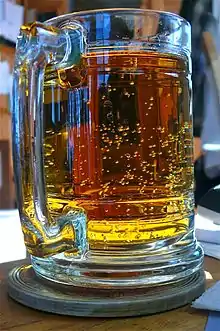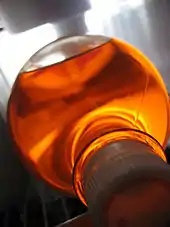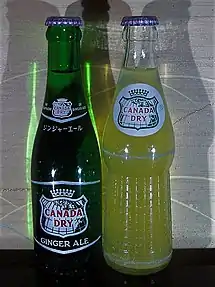Ginger ale
Ginger ale is a carbonated soft drink flavoured with ginger. It is consumed on its own or used as a mixer, often with spirit-based drinks. There are two main types of ginger ale. The golden style is credited to the Irish doctor Thomas Joseph Cantrell. The dry style (also called the pale style), a paler drink with a much milder ginger flavour, was created by Canadian John McLaughlin.
 A glass of Vernors ginger ale | |
| Type | Non-alcoholic mixed drink |
|---|---|
| Country of origin | United Kingdom and Canada |
| Region of origin | Northern Ireland |
| Introduced | 1851 |
| Proof (US) | 0% |
| Colour | Golden |
| Flavour | Ginger |
| Variants | Golden ginger ale and dry ginger ale |
History
Thomas Joseph Cantrell, an Irish apothecary and surgeon, claimed to have invented ginger ale in Belfast, Northern Ireland in the 1850s, and marketed it with local beverage manufacturer Grattan and Company.[1] Grattan embossed the slogan "The Original Makers of Ginger Ale" on its bottles.[2] This was the older style golden ginger ale, dark coloured, generally sweet to taste, with a strong ginger spice flavour. Ginger ale is clear; ginger beer is often cloudy due to the residues of brewing, and has a stronger ginger taste.

Dry ginger ale is recognized as a Canadian creation by John J. McLaughlin, a chemist and pharmacist.[3] Having established a soda water bottling plant in 1890, McLaughlin began developing flavour extracts to add to the water in 1904. That year, he introduced "Pale Dry Ginger Ale", the bubbly drink that would be patented in 1907 as "Canada Dry Ginger Ale". An instant success, Canada Dry products were accepted by appointment to the Vice-Regal Household of the Governor General of Canada. The dry-style also became popular in the United States during the Prohibition era, when it was used as a mixer for alcoholic beverages. Dry ginger ale quickly surpassed golden ginger ale in popularity. Today, golden ginger ale is an uncommon, more regional drink exemplified by Vernors. By contrast, dry ginger ale is produced on a large scale internationally, and is a staple in supermarkets and bars, and on airlines.
Ingredients
Commercial ginger ale commonly contains carbonated water, sugar or high-fructose corn syrup, and artificial or natural ginger-flavour. Ginger content is often listed on labels in a general "natural aroma" or "natural flavoring" statement, to preserve secrecy of the complex proprietary mix of spices, fruits and other flavours used; lemon, lime, and cane sugar are the most common ingredients. Pineapple and honey are also occasionally used.
Traditional ginger ale is made from a microbial starter culture (yeast or ginger bug), sugar, fresh ginger root, other flavourings and water. Ginger bug can be derived from ginger beer plant containing Saccharomyces florentinus and Lactobacillus hilgardii or fresh ginger root containing Lactobacillus bacteria and wild yeast. The carbonation comes from the yeast fermentation as opposed to carbonating the finished product. Ethanol, as a byproduct of fermentation, will be present in the ginger ale but can be controlled by modifying fermentation time.
Processing
Fermentation

To make traditional ginger ale, yeast or ginger bug[4] is added to the initial ginger preparation containing sugar and other flavourings. Sugar is added because ginger does not contain enough for the entire fermentation process (1.7g sugar/100g ginger).[5] Like other fermented beverages, the sugar present in the preparation is fermented by the microorganism into ethanol and carbon dioxide.[6] In yeast, the enzyme responsible for fermentation is known as zymase. Fermentation must be conducted in an air-tight container in order to achieve carbonation.
Carbonation
Traditional ginger ale will contain carbon dioxide as a result of fermentation, but most commercial ginger ale bottlers will carbonate the final product instead. First, the water is chilled to a low temperature to allow more carbon dioxide to be dissolved.[7] Then, alkaline compounds such as sodium bicarbonate may be added to reduce acidity. Lastly, carbon dioxide is added and slightly over-pressurized to facilitate movement into storage and the filling machine.[7]
Preservation

Preservation of commercial ginger ale is usually done by adding a solution of salicylic acid, which has bactericidal and antiseptic properties. Another method of preservation is to use steam heating.[8]
Canada Dry Ginger ale has an acidic pH of 2.82, due to the relatively high concentration of carbonic acid it contains. This preserves the product in that foods with pH below 4.6 do not support microorganism growth.[9][8]
Uses
Health effects
Ginger ale, as with other ginger products and other non-ginger-flavored carbonated beverages, is often recommended as a home remedy for indigestion[10] and motion sickness.[11] It is also used to soothe coughs and sore throats.[12]
Ginger ale is usually acceptable for people on a clear liquid diet.[13]
Uses as a drink
It is popular in mixed drinks, and punch, and it is sometimes used as a non-alcoholic substitute for champagne or beer, since the beverages resemble each other in appearance. Ginger ale can be mixed with many hard liquors, beers and wines. In Jamaica, a common way to consume ginger ale is mixed with Red Stripe beer; this is called a Shandy Gaff.[15]
Variations
Ginger ale vs ginger beer
Ginger ale and ginger beer are similar beverages, however, there are clear differences during the process. Ginger beer originated in England in the 1800s while ginger ale was founded in Ireland approximately 50 years later before it was modernized in 1907 by John McLaughlin.[16] Original ginger beer contains 11% alcohol, but modern ginger beer contains less than 0.5% alcohol while modern ginger ale has absolutely no alcohol content.[17] Ginger beer is brewed with natural ginger, lemon juice, sugar and it is fermented with a ginger beer plant culture (mainly lactobacillus). The fermentation of the lactobacillus produces a cloudy appearance, stronger-tasting and spicier flavour compared to ginger ale. Other differences between ginger ale and ginger beer are in terms of taste and aroma. While Ginger ale is mellow and smells sweet, ginger beer has a spicy whiff and gingery taste.[18]
Other flavours
Dry ginger ale is also sold with a mint flavouring added. Some mint ginger ale brands have an artificial green colour added, while others are clear. Canada Dry has introduced a line of ginger ale mixed with green tea and one mixed with lemonade. In selected Japanese vending machines, Canada Dry also offers hot ginger ale, which is the heated version of the original but still retains carbonation.[19]
Manufacturers

Vernors, Blenheim, A-Treat, Bull's Head, Chelmsford, Buffalo Rock, Sussex and Red Rock are brands of golden ginger ale. Canada Dry, Schweppes, and Seagram's are major brands of dry ginger ale.
North America
American brands include Canfield's, Hansen Natural, Vernors, Buffalo Rock, Boylan Bottling Company, Polar Beverages, Ale-8-One, Blenheim, Foxon Park, Fitz's, Sprecher, Market Basket/Chelmsford, Red Rock, Reed's Ginger Brew, Chek (River of Dreams), Shasta, and in Canada; Sussex Golden Ginger Ale. Major global brands include Canada Dry, Seagram's, both Canadian companies, and Schweppes, founded in Geneva.
Vernors is a flavoured golden ginger ale aged for three years in oak barrels before bottling. It was the first U.S. soft drink, originating in 1866, although it was modelled on imported Irish ginger beers. In Detroit, Michigan, a drink made with vanilla ice cream and Vernors ginger ale is called a Boston cooler.
Blenheim is a golden ginger ale made in South Carolina; unlike most other brands, it is available in several degrees of spiciness: Old #3 Hot, #5 Not as Hot, and #9 Diet.[20]
South America
- Cunnington
Asia
- Evervess
- East Imperial
See also
- Ginger beer
- Ginger tea
- Ginger wine
- List of brand name soft drinks products
- List of soft drink flavors
- List of soft drink producers
- List of soft drinks by country
- Switchel
- Reed's, Inc.
References
- "THE SPARKLING HISTORY OF CANTRELL & COCHRANE". Let's Look Again. November 2016. Retrieved October 19, 2018.
- "Federation of Historical Bottle Collectors" (PDF). FOHBC. Retrieved October 3, 2013.
- "Canadian food firsts". Canadian Geographic. January–February 2002. Archived from the original on June 24, 2013. Retrieved October 31, 2012.
- Graham, Colleen. "Make a Ginger Bug for Healthy Homemade Sodas". The Spruce Eats. Dotdash. Retrieved July 29, 2020.
- "Food Composition Databases Show Foods -- Ginger root, raw". ndb.nal.usda.gov. Retrieved August 9, 2018.
- "How to Make Alcoholic Ginger Ale". Homebrewing Learn Center. June 13, 2016. Retrieved August 9, 2018.
- "How soft drink is made - production process, making, history, used, product, industry, machine". www.madehow.com. Retrieved August 9, 2018.
- "How To Prepare And Preserve Ginger Ale". chestofbooks.com. Retrieved August 9, 2018.
- Reddy, Avanija (2016). "pH of beverages in the United States". Journal of the American Dental Association.
- Geographic, National (2014). National Geographic Complete Guide to Natural Home Remedies: 1,025 Easy Ways to Live Longer, Feel Better, and Enrich Your Life. National Geographic Books. p. 28. ISBN 9781426212604.
- Naranjo, Ralph (September 12, 2014). The Art of Seamanship: Evolving Skills, Exploring Oceans, and Handling Wind, Waves, and Weather. McGraw Hill Professional. pp. 66–67. ISBN 9780071791588.
- "Ginger for Sore Throat: Benefits, Uses, and Recipe". Healthline. Retrieved August 18, 2019.
- Williams, Patricia A. (December 23, 2016). deWit's Fundamental Concepts and Skills for Nursing - E-Book. Elsevier Health Sciences. p. 487. ISBN 9780323483285.
- "Schweppes Ginger Ale | Nutritional Information and Ingredients". www.coca-cola.ie. Retrieved August 18, 2019.
- "Drinks containing Ginger Ale. Choose from 234 drink recipes containing Ginger Ale". Bar None Drinks. Retrieved January 5, 2013.
- Daily, Kitchen (April 20, 2012). "The Difference Between Ginger Ale And Ginger Beer". Huffington Post. Retrieved August 9, 2018.
- "What's the Difference Between Ginger Beer and Ginger Ale?". Town & Country. February 13, 2018. Retrieved August 9, 2018.
- "Ginger Beer vs Ginger Ale: Which One Should You Use?". Advanced Mixology. Retrieved August 18, 2019.
- "Coca-Cola to Release First Hot Soft Drink". Retrieved March 2, 2017.
- "Products « Blenheim Ginger Ale". Blenheim Ginger Ale. August 13, 2013. Retrieved October 3, 2013.
External links
| Wikimedia Commons has media related to Ginger ale. |
| Look up ginger ale in Wiktionary, the free dictionary. |